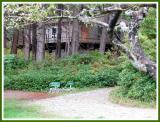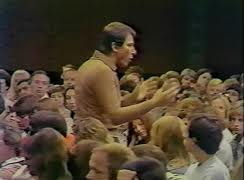
Raven meeting room at Cold Mountain Institute, where I had many breakthroughs and a few transformational experiences
What was the difference between life lived on the awareness path and life not so lived? In some respects, that was indicated by what it was like to meet one of the path’s adherents when one did not follow the path.
I think the most startling thing one noticed when one met one for the first time was that they called themselves on their own manipulations and deceit.
To actually call oneself on one’s own behavior was regarded as a contribution to the awareness enterprise – one’s “ante” in the game. It was viewed as a lesser contribution to allow others to call you. To not cop to what one was being called on was accepted among new arrivals but not admired or brooked much in one who had been there a while.
If one persisted in resisting the insights that were generated, if one refused to try them on and test them out, then one wasn’t seen as taking advantage of what was happening and being offered. People who continued to refuse to “take a look” usually left the group before too long. Those who remained were seen as having accomplished something simply by sticking it out.
I wouldn’t want you to get the impression that all of us wandered around endlessly saying “I’m aware of.” That was one road in to the awareness game but quickly multiplied into “What I notice about myself,” “what I see as true for me,” “I tell myself,” I watch myself thinking,” etc. This reflective communicational practice was another reason why we were called “the Me Generation,” but again that was a superficial understanding of what we were up to.
Admittedly some people at a gathering or a party would very intentionally say “I’m aware of” and look each other in the eye. That was often a signal that that person wanted to meet others into the awareness game and would inevitably lead to a group hiving itself from the larger setting and getting into an animated conversation.
I remember first arriving at Cold Mountain Institute for a three-month resident fellowship, which amounted to three months of encounter groups and therapeutic workshops. I had set aside a substantial sum of money to take it. It was held at a rural retreat on Vancouver Island in Canada’s western province of British Columbia. The retreat center was built on a spectacular bluff overlooking the ocean.
On the first day, I was sitting having lunch with other residents and listening to their conversation. Knowing who was a newbie and who was not seemed to be characterized by who was “calling himself” on his own games and how seamless and devoid of ego the person was who was doing so.
The opposite of such a conversation would be to sit there and hear one person blaming another. A slightly more proficient level would be to call one’s self but to be too eager and enthusiastic in doing so.
But the people whom we admired would be, from time to time, transparent about some pretty difficult things or call themselves on their own stuff in a very proficient but low-key and seamless manner. It was an eye-opener and a joy to watch and hear. The more difficult it was to call or reveal, the more impressive. But it was also balanced off by the appropriateness of it and how it was done.
Another indicator of proficiency lay in how one called another. If it was done in a blaming manner, again low marks – and that usually brought an intervention from someone.
If it was done in a blameless but too eager and enthusiastic manner, again low marks. That usually just brought silence from everyone else. It was obvious that one had dropped a brick.
But if it was done in a low-key, seamless and almost invisible and harmless manner, very high marks.
We were all breaking ground not only on how far we could extend our awareness and how harmless we could be with another, but also on how far we could go in our awareness without launching ourselves into some new dysfunctionality. It was a very subtle and empowering practice that we were engaged in when it was done well. The very best practitioners were wonderful to watch and listen to.
One of the most proficient and impactful demonstrations I ever watched was from a friend on my three-month fellowship who stood up for what may have been five minutes at lunch and simply said “I feel” and filled in the blanks. It’s probably hard to recreate what he did. It won’t sound like anything in print. But he matched his disclosure to the change in his emotions so that he was transparent to us all as one feeling shaded into another.
He began with saying something such as that he felt happy, which he would repeat until it shaded off into feeling something else. His sensitivity to the changes in his mood and his willingness to stand there transparently allowing his emotions to be expressed as he chronicled them was marvellous to watch. It was a huge inspiration to the rest of us. It was the closest thing to being in his skin that I could imagine and it had many of us in tears.
To be willing and able to call oneself separated the men from the boys or the women from the girls in awareness circles. Many people think that encounter groups were all about calling others on their stuff. Well, I suppose they were in the beginning of a workshop and especially with one who was unwilling to be honest or forthcoming.
But very soon an encounter group became about calling oneself on one’s own bullsh*t. And the more one was willing to call oneself, the deeper the sharing would go. By the end of the group, there was no need for encounter. People were sharing deeply without the need to be “called.” And that’s where encounter groups led – to their own demise within a single session as an “encounter” group and their rise as a “sharing” and “consciousness-raising” group.
The “awareness game,” as we called it, was in the beginning very much a solitary enterprise. One of the innovations of the est Training was that it became by contrast a shared enterprise. There was very much a leading edge to awareness and much was made of “pushing our edge.” Sharing the enterprise meant that the leading edge of awareness was pushed forward a lot more rapidly and extensively than with the awareness game up to that point.
Nowhere was this more visible than watching a series of lectures one day by two of the “gurus” of the growth movement, two instructors from my own three-month resident fellowship in fact, and the best of the bunch in my opinion, speaking alongside a woman, a singer famous in her day, who had taken the est Training. The instructors seemed almost morose compared to the enthusiasm and spontaneity of the latter. I was amazed to see the difference in the heights of grounded expression they could reach. And it definitely resonated with me.
There will be some who will say that est was hype and conformity and so on. Many people who felt that way were usually not people who really explored what it had to offer. In defending est, I’m quite aware that I open myself to possible derision.
Those who didn’t like what est was about would portray est practitioners as wide-eyed and self-deluded. Some may have been but not a lot, as far as I was aware. Those who really benefited from it came to understand their own behavior, their own aims and ways of being at a far deeper level than those who did not, whatever the price paid in being a part of a large movement.
I left est because I could no longer stand what they called “the guest game,” the enrollment practices that existed at the time. But I was always amazed at what I learned from it and from growth practitioners like John Enright who hoed the same rows as est. It has served me to this day. In fact, whenever I express a point of view on something that really rings true for me, I’m amazed at how often I’m repeating something I learned from John or Werner.
Awareness as a solvent of dysfunctionality was excellent and ever after I found myself attracted to those who wanted to be aware of their own dysfunctional and successful ways of being. You could spot such people anywhere by just listening to the way they spoke.
Admittedly today, I haven’t heard such conversation very much around me. We seem to have lost our inheritance from those times and I have no clue how to re-ignite the inquiry, although I think it will re-ignite itself at some point. But I do remember how my ears would perk up the moment I heard someone say “I’m aware of.” I would leave one conversation and gravitate to the other whenever I heard that phrase.
I have to acknowledge that I’ve fallen quite a bit from the practices of these times and writing this series was in part designed to remind myself of what my own path is all about before I really need to rely on it. In that it’s been very useful.
Some of you oldie yogis have written me and said how much you enjoyed this series. You were either in consciousness-raising groups, the encounter movement, est, or some other wing of the awareness movement. I personally have little time these days for membership in groups, I’m afraid, but I’ll support anyone who wishes to reintroduce awareness practices into the Ascension movement in any way I can.
Others have written and said how much they enjoy the fact that I write transparently. When you do so, you’re not acknowledging me. You’re acknowledging the awareness movement. The past four years, I’ve been writing from the standpoint of raising awareness or consciousness. I’ll be happy when I see more veterans of the path of awareness join in and shift the way we speak today from whatever it is at the moment to a point of mutual transparency, personal responsibility, and self-awareness.



